A Review on Tribological Wear and Corrosion Resistance of Surface Coatings on Steel Substrates
Abstract
1. Introduction
2. Coating Preparation Methods
2.1. CVD Method
2.2. PVD Method
2.3. Laser Cladding Method
- Qiu et al. [50] fabricated gradient composite coatings containing ZrB2 on 27SiMn steel. The 20% ZrB2 variant demonstrated the optimal tribological performance, exhibiting the lowest coefficient of friction and minimal wear volume.
- Zhang et al. [51] addressed cavitation erosion (a form of wear) in marine pumps by fabricating cobalt-based coatings on 316 stainless steel, which exhibited only 1/3 the weight loss rate of the substrate.
- HSLC was employed by Hu et al. [52] to synthesize Ni/WC composite coatings on 304 steel. The resultant coatings showed an eightfold enhancement in stable wear resistance along with a reduced coefficient of friction.
2.4. Plasma Spraying Technology
3. Strategies for Tribological Optimization of Coatings
3.1. Wear-Resistant Coating
3.2. Friction-Reducing Coating
3.3. Self-Lubricating Coating
4. Enhancing Corrosion Resistance of Surface Coatings on Steel
4.1. Mechanisms of Corrosion Protection by Coatings
4.1.1. Barrier Protection
4.1.2. Active Inhibition
4.1.3. Sacrificial Protection
4.1.4. Self-Healing Protection
4.2. Corrosion Performance of Coating Systems
4.2.1. Metallic and Alloy Coatings
4.2.2. Inorganic and Ceramic Coatings
4.2.3. Organic and Polymer-Based Coatings
4.3. Synergistic Effects of Wear and Corrosion
5. Summary and Prospects
5.1. Research Summary
5.2. Future Outlook
- Advanced Coating Systems and Architectures: The design of next-generation coatings will increasingly utilize multilayer, gradient, and composite architectures. These intelligent designs aim to seamlessly combine properties such as hardness, toughness, and corrosion resistance, which are often mutually exclusive in single-layer coatings. There is significant potential in hybrid processing techniques (e.g., combining PVD with laser texturing or thermal spraying) to create synergistic surface systems with tailored functionalities.
- Decoding Degradation Mechanisms under Synergistic Attacks: A paramount challenge is to fundamentally understand coating failure under combined tribological-corrosion (tribocorrosion) loads. Future work should employ in situ characterization techniques and multi-scale modeling to elucidate the real-time interaction between mechanical wear and electrochemical dissolution, particularly in complex environments involving elevated temperatures, erosion, and fatigue.
- Leveraging AI and Advanced Manufacturing: The integration of artificial intelligence and machine learning with materials science is anticipated to accelerate the discovery and optimization of coating compositions and processes. Furthermore, advances in additive manufacturing and laser processing will enable the fabrication of coatings with precisely controlled geometries and site-specific properties, opening new avenues for repairing and enhancing critical components.
- Sustainability and Life Cycle Engineering: As industries move towards greener practices, the development of environmentally friendly coating processes and materials will be crucial. Research will focus on reducing energy consumption during deposition, utilizing non-toxic elements, and designing coatings for extended service life to minimize resource use and waste throughout the entire component life cycle.
- Standardization and Performance Prediction: Establishing robust, standardized testing protocols that accurately simulate complex service conditions is essential for reliable performance comparison. Concurrently, efforts should be directed towards developing predictive models for coating service life, which will de-risk the implementation of new coating technologies in demanding industrial applications such as aerospace, marine engineering, and renewable energy systems.
5.3. Conclusions
Funding
Institutional Review Board Statement
Informed Consent Statement
Data Availability Statement
Conflicts of Interest
References
- Anitha, N.; Krishnaveni, A.; Prathipa, V.; Priya, S.S.; Jewelcy, A.L.; Anucia, T.A.A.; Parimala, S.; Jasmine, V.I.; Yuvarani, V.; Nivetha, M.V.; et al. Electrochemical studies on the corrosion resistance of mild steel in 1 M HCl solution before and after emulsion coating. Int. J. Corros. Scale Inhib. 2023, 11, 708–721. [Google Scholar] [CrossRef]
- Pokorný, P.; Kouřil, M. Predicted Corrosion Performance of Organofunctional Silane Coated Steel Reinforcement for Concrete Structures: An Overview. Buildings 2024, 14, 1756. [Google Scholar] [CrossRef]
- Coni, N.; Gipiela, M.L.; D’Oliveira, A.S.C.M.; Marcondes, P.V.P. Study of the mechanical properties of the hot dip galvanized steel and galvalume®. J. Braz. Soc. Mech. Sci. Eng. 2009, 31, 319–326. [Google Scholar] [CrossRef]
- Basdeki, M.; Apostolopoulos, C. The Effect of Shot Blasting Process on Mechanical Properties and Anti-Corrosive Behavior of Steel Reinforcement. Metals 2022, 12, 275. [Google Scholar] [CrossRef]
- Albizu, G.; Ostra, M.; Bordagaray, A.; Garcia-Arrona, R.; Vidal, M. Maintenance and control of coating baths: Rapid and simultaneous hypophosphite and phosphite determination in a Ni P deposition bath. Surf. Coat. Technol. 2024, 478, 130423. [Google Scholar] [CrossRef]
- Suzuki, Y.; Morishita, A. Influence of Corrosion Inhibitor in Chemical Conversion Coatings on Corrosion Performance in Scratches in Zinc-Coated Steels. ISIJ Int. 2019, 59, 1878–1885. [Google Scholar] [CrossRef]
- Zang, L.; Chen, Y.; Wu, Y.; Zheng, Y.; Chen, H.; You, D.; Li, L.; Li, J. Comparative tribological and friction behaviors of oil-lubricated manganese phosphate conversion coatings with different crystal sizes on AISI 52100 steel. Wear 2020, 458–459, 203427. [Google Scholar] [CrossRef]
- Apostolopoulos, C.A.; Koulouris, K. Corrosion Effect on Bond Loss between steel and concrete. In Structural Integrity and Failure; Oyguc, R., Tahmasebinia, F., Eds.; IntechOpen: London, UK, 2020. [Google Scholar]
- Lu, P.; Xu, Z.; Tian, Y.; Yang, R.; Hu, K.; Li, H.; Yin, Y.; Chen, X. Effect of Initial Surface Scratches on the Cavitation Erosion Behavior of 316L Stainless Steel Substrates and 316L Stainless Steel Coatings. Materials 2023, 16, 1392. [Google Scholar] [CrossRef]
- Lungu, M.V.; Tălpeanu, D.; Ciobanu, R.C.; Cojocaru, A.; Pătroi, D.; Marinescu, V.; Caramitu, A.R. Evaluation of Magnetron Sputtered TiAlSiN-Based Thin Films as Protective Coatings for Tool Steel Surfaces. Coatings 2024, 14, 1184. [Google Scholar] [CrossRef]
- Varis, T.; Lagerbom, J.; Suhonen, T.; Raami, L.; Terho, S.; Laurila, J.; Peura, P.; Vuoristo, P. Effect of heat treatments on the wear resistance of HVAF and HVOF sprayed tool steel coatings. Surf. Coat. Technol. 2023, 462, 129508. [Google Scholar] [CrossRef]
- Han, W.; Meng, X.M.; Zhao, J.; Zhang, J.B. Effect of heat treatment on microstructure and bending behaviour of 304 stainless steel coating by cold gas dynamic spraying. Mater. Res. Innov. 2012, 16, 109–114. [Google Scholar] [CrossRef]
- Durán, A.; Castro, Y.; Conde, A.; De, J.J. Handbook of Sol-Gel Science and Technology; Springer: Cham, Switzerland, 2016. [Google Scholar] [CrossRef]
- Liu, Q.; Cao, Y.; Chen, S.; Xu, X.; Yao, M.; Fang, J.; Lei, K.; Liu, G. Hot-Dip Galvanizing Process and the Influence of Metallic Elements on Composite Coatings. J. Compos. Sci. 2024, 8, 160. [Google Scholar] [CrossRef]
- Khan, H.H.; Wang, T.; Su, L.; Li, H.; Zhu, Q.; Yang, A.; Li, Z.; Wang, W.; Zhu, H. In Situ Thermal Interactions of Cu-Based Anti-Corrosion Coatings on Steel Implemented by Surface Alloying. Coatings 2024, 14, 722. [Google Scholar] [CrossRef]
- Chiadikobi, C.I.; Thornton, R.; Statharas, D.; Weston, D.P. The effects of deep cryogenic treatment on PVD-TiN coated AISI M2 high speed steel. Surf. Coat. Technol. 2024, 493, 131248. [Google Scholar] [CrossRef]
- Bobzin, K.; Kalscheuer, C.; Tayyab, M. A case study on fatigue damage in PVD coated tool steel under cyclic bending load. Surf. Coat. Technol. 2024, 478, 130505. [Google Scholar] [CrossRef]
- Zhang, R.; Yang, K.; Dang, B.; Zhan, M.; Zhang, P.; Li, S. Anti-Corrosion and Wave-Absorbing Properties of Epoxy-Based Coatings on Q235 Steel. Coatings 2024, 14, 1315. [Google Scholar] [CrossRef]
- Sakib, M.N.; Iqba, A.A. Epoxy Based Nanocomposite Material for Automotive Application—A Short Review. Int. J. Automot. Mech. Eng. 2021, 18, 9127–9140. [Google Scholar] [CrossRef]
- Bansal, P.; Singh, G.; Sidhu, H.S. Investigation of Surface Properties and Corrosion Behavior of Plasma Sprayed HA/ZnO Coatings Prepared on AZ31 Mg Alloy. Surf. Coat. Technol. 2020, 401, 126241. [Google Scholar] [CrossRef]
- Zhang, X.; Wei, L.; Liu, P.; Wang, S.; Ye, S.; Chen, Y. Influence of Protective Coating at High Temperature on Surface Quality of Stainless Steel. J. Iron Steel Res. Int. 2014, 21, 202–207. [Google Scholar] [CrossRef]
- Aiso, T.; Wiklund, U.; Kubota, M.; Jacobson, S. Effect of Si and Al additions to carbon steel on material transfer and coating damage mechanism in turning with CVD coated tools. Wear 2016, 368–369, 379–389. [Google Scholar] [CrossRef]
- Zhao, Q.; Geng, S.; Chen, G.; Wang, F. Initial Oxidation Behavior of Ferritic Stainless Steel Interconnect with Sputtered NiFe2 Alloy Coating. Oxid. Met. 2020, 93, 283–299. [Google Scholar] [CrossRef]
- ONgasoh, F.; Anye, V.C.; Agyei-Tuffour, B.; Oyewole, O.K.; Onwualu, P.A.; Soboyejo, W.O. Corrosion behavior of 5-hydroxytryptophan (HTP)/epoxy and clay particle-reinforced epoxy composite steel coatings. Cogent Eng. 2020, 7, 1797982. [Google Scholar] [CrossRef]
- Lehmusto, J.; Yrjas, P.; Hupa, L. Pre-oxidation as a means to increase corrosion resistance of commercial superheater steels. Oxid. Met. 2019, 91, 311. [Google Scholar] [CrossRef]
- Karimbaev, R.; Pyun, Y.S.; Maleki, E.; Unal, O.; Amanov, A. An improvement in fatigue behavior of AISI 4340 steel by shot peening and ultrasonic nanocrystal surface modification. Mater. Sci. Eng. A 2020, 791, 139752. [Google Scholar] [CrossRef]
- Hou, X.; Zhang, H.; Seraffon, M.; Fry, A.T. Steam oxidation and mechanical performance of a ferritic–martensitic steel with slurry aluminide coating. Mater. Corros. 2020, 71, 1310–1320. [Google Scholar] [CrossRef]
- Dryepondt, S.; Zhang, Y.; Pint, B.A. Creep and corrosion testing of aluminide coatings on ferritic–martensitic substrates. Surf. Coat. Technol. 2006, 201, 3880–3884. [Google Scholar] [CrossRef]
- Chang, J.-K.; Lin, C.-S.; Wang, W.-R.; Jian, S.-Y. High temperature deformation behaviors of hot dip 55 wt% Al-Zn coated steel. Appl. Surf. Sci. 2020, 511, 145550. [Google Scholar] [CrossRef]
- Parekh, T.; Patel, P.; Sasmal, C.S.; Jamnapara, N.I. Effect of plasma processed Ti-Al coating on oxidation and tensile behavior of Ti6Al4V alloy. Surf. Coat. Technol. 2020, 394, 125704. [Google Scholar] [CrossRef]
- Gu, Y.; Xia, K.; Wu, D.; Mou, J.; Zheng, S. Technical Characteristics and Wear-Resistant Mechanism of Nano Coatings: A Review. Coatings 2020, 10, 233. [Google Scholar] [CrossRef]
- Kukla, D.; Kopec, M.; Kowalewski, Z.L.; Politis, D.J.; Jóźwiak, S.; Senderowski, C. Thermal Barrier Stability and Wear Behavior of CVD Deposited Aluminide Coatings for MAR 247 Nickel Superalloy. Materials 2020, 13, 3863. [Google Scholar] [CrossRef]
- Pierpaoli, M.; Sawczak, M.; Dettlaff, A. Development of Microstructured Carbon Coatings by Substrate-Catalytic CVD. Coatings 2021, 11, 1403. [Google Scholar] [CrossRef]
- Raman, R.K.S.; Sanjid, A.; Banerjee, P.C.; Arya, A.K.; Parmar, R.; Amati, M.; Gregoratti, L. Remarkably corrosion resistant graphene coating on steel enabled through metallurgical tailoring. Small 2024, 20, 2302498. [Google Scholar] [CrossRef]
- Zhang, Y.; Pint, B.A.; Cooley, K.M.; Haynes, J.A. Formation of aluminide coatings on Fe-based alloys by chemical vapor deposition. Surf. Coat. Technol. 2008, 202, 3839–3849. [Google Scholar] [CrossRef]
- Bareiβ, J.C.; Hackl, G.; Popovska, N.; Rosiwal, S.M.; Singer, R.F. CVD diamond coating of steel on a CVD-TiBN interlayer. Surf. Coat. Technol. 2006, 201, 718–723. [Google Scholar] [CrossRef]
- Thelen, F.; Zehl, R.; Bürgel, J.L.; Depla, D.; Ludwig, A. A python-based approach to sputter deposition simulations in combinatorial materials science. Surf. Coat. Technol. 2025, 503, 131998. [Google Scholar] [CrossRef]
- Zhang, Y.; Wang, Q.; Ramachandran, C.S.; Guo, P.; Wang, A. Microstructure and Performance of High-Velocity Oxygen-Fuel Coupled Physical Vapor Deposition (HVOF-PVD) Duplex Protective Coatings: A Review. Coatings 2022, 12, 1395. [Google Scholar] [CrossRef]
- Šturm, R.; Žnidaršič, M.; Grum, J. Crack-Growth Behavior of Laser Surface-Alloyed Low-Carbon Steel. J. Mater. Eng. Perform. 2013, 22, 2542–2549. [Google Scholar] [CrossRef]
- Kim, H.; Mandel, M.; Dalke, A.; Biermann, H.; Krüger, L. Effect of nitriding pre-treatment on the tribocorrosion behavior of physical vapor deposition-coated tool steel. Eng. Rep. 2022, 4, e12382. [Google Scholar] [CrossRef]
- Lotfi-khojasteh, E.; Sahebazamani, M.; Elmkhah, H.; Nouri, M.; Imantalab, O.; Fattah-alhosseini, A. A study of the electrochemical and tribological properties of TiN/CrN nano-layer coating deposited on carburized-H13 hot-work steel by Arc-PVD technique. J. Asian Ceram. Soc. 2020, 9, 270–282. [Google Scholar] [CrossRef]
- Hwang, Y.-H.; Seo, K.-J.; Kim, T.-H.; Min, Y.J.; Liu, Y.; Kim, D.-E. Tribological behavior of TiN, AlTiN, and AlTiCrN coatings in atmospheric and vacuum environments. Friction 2024, 12, 2611–2626. [Google Scholar] [CrossRef]
- Arulvel, S.; Winfred, R.D.D.; Akshat, J.; Jayakrishna, K.; Mridul, S. Laser processing techniques for surface property enhancement: Focus on material advancement. Surf. Interfaces 2023, 42, 103293. [Google Scholar]
- Noli, F.; Misaelides, P.; Riviere, J.P. Enhancement of the corrosion resistance of a Ti-based alloy by ion beam deposition methods. Nucl. Instrum. Methods Phys. Res. Sect. B Beam Interact. Mater. At. 2009, 267, 1670–1674. [Google Scholar] [CrossRef]
- Lu, K.; Zhu, J.; Guo, D.; Yang, M.; Sun, H.; Wang, Z.; Hui, X.; Wu, Y. Microstructures, Corrosion Resistance and Wear Resistance of High-Entropy Alloys Coatings with Various Compositions Prepared by Laser Cladding: A Review. Coatings 2022, 12, 1023. [Google Scholar] [CrossRef]
- Yang, Z.-Q.; Kuo, H.-M.; Chiang, H.-C.; Hung, C.-H. Enhanced wear resistance of low carbon steel by depositing iron-chromium alloy coating using high-power laser cladding. Int. J. Adv. Manuf. Technol. 2025, 137, 1133–1147. [Google Scholar] [CrossRef]
- Lu, D.; Cui, X.; Zhang, J. Microstructure and properties of high entropy alloy coating obtained by laser cladding. Sci. Rep. 2025, 15, 7357. [Google Scholar] [CrossRef]
- Jelvani, S.; Razavi, R.S.; Barekat, M.; Dehnavi, M.R.; Erfanmanesh, M. Evaluation of solidification and microstructure in laser cladding Inconel 718 superalloy. Opt. Laser Technol. 2019, 120, 105761. [Google Scholar] [CrossRef]
- Singh, R.; Kumar, D.; Mishra, S.K.; Tiwari, S. Laser cladding of Stellite 6 on stainless steel to enhance solid particle erosion and cavitation resistance. Surf. Coat. Technol. 2014, 251, 87–97. [Google Scholar] [CrossRef]
- Qiu, Y.; Wang, Y.; Shu, L.; Huang, T.; Shi, J.; Li, P. Microstructure and properties of ni-ZrB2 gradient composite coating on the 27SiMn steel surface by laser cladding. Mater. Today Commun. 2025, 43, 111657. [Google Scholar] [CrossRef]
- Zhang, J.; Xu, Q.; Ding, Q.; Duan, J.; Xu, Y.; Ji, F. Microstructure characteristics and cavitation erosion resistance of co-based coating fabricated via laser cladding. J. Laser Appl. 2025, 37, 012035. [Google Scholar] [CrossRef]
- Hu, Z.; Li, Y.; Lu, B.; Tan, N.; Cai, L.; Yong, Q. Effect of WC content on microstructure and properties of high-speed laser cladding ni-based coating. Opt. Laser Technol. 2022, 155, 108449. [Google Scholar] [CrossRef]
- Kornienko, E.E.; Lapushkina, E.J.; Kuzmin, V.I.; Vaschenko, S.P.; Gulyaev, I.P.; Kartaev, E.V.; Sergachev, D.S.; Kashapov, N.; Sharifullin, S.; Fayrushin, I. Air Plasma Sprayed Coatings of Self-Fluxing Powder Materials. J. Phys. 2014, 567, 012010. [Google Scholar] [CrossRef]
- Martin, D.T.; Rad, M.Z.; Macdonald, A.; Hussain, T. Beyond Traditional Coatings, a review on Thermal Sprayed and Smart coatings. J. Therm. Spray Tech. 2019, 28, 598–644. [Google Scholar] [CrossRef]
- Fotovvati, B.; Namdari, N.; Dehghanghadikolaei, A. On Coating Techniques for Surface Protection: A Review. J. Manuf. Mater. Process. 2019, 3, 28. [Google Scholar] [CrossRef]
- Medabalimi, S.; Gudala, S.; Rokkala, U.; Hebbale, A.M.; Ramesh, M.R. Microstructure and elevated temperature wear behavior of HVOF-sprayed SS304L stainless-steel coating. Discov. Appl. Sci. 2025, 7, 428. [Google Scholar] [CrossRef]
- Gao, Y.; Bai, S.; Kou, G.; Jiang, S.; Liu, Y.; Zhang, D. Microstructure Characteristics and Elevated-Temperature Wear Mechanism of FeCoCrNiAl High-Entropy Alloy Prepared by Laser Cladding. Processes 2024, 12, 2228. [Google Scholar] [CrossRef]
- Wang, Y.; Wan, W.; Mao, J.; Tian, L.; Li, R. Microstructure and Wear Behavior of Plasma-Sprayed TiO2–SiAlON Ceramic Coating. Coatings 2020, 10, 1268. [Google Scholar] [CrossRef]
- Firouzbakht, A.; Razavi, M.; Rahimipour, M.R. In Situ Synthesis of Fe–TiC Nanocomposite Coating on CK45 Steel From Ilmenite Concentrate by Plasma-Spray Method. J. Tribol. 2017, 139, 011302. [Google Scholar] [CrossRef]
- Li, F.; Sun, S.; Xu, Y.; Tian, L.; Wang, Y.; Xu, Z.; Li, R. Microstructure and Wear Behaviors of Plasma-Sprayed MoAlB Ceramic Coating. Coatings 2021, 11, 474. [Google Scholar] [CrossRef]
- Lakkannavar, V.; Yogesha, K.B.; Prasad, C.D.; Tiwari, A.; Vanitha, K.; Soni, P.K. Evaluation of mechanical, metallurgical, and hot corrosion-erosion behavior of plasma sprayed Ni22Cr10Al0.8Y/30%Cr3C2 /10%h-BN/10% mo composite coating. Surf. Coat. Technol. 2025, 497, 131730. [Google Scholar] [CrossRef]
- Özel, S. The effect of coating parameter on properties of plasma sprayed co based coatings. Teh. Vjesn. 2019, 26, 318–322. [Google Scholar] [CrossRef]
- Wang, C.; Liu, J.; Liu, G.; Xue, L.; Zhang, K. Tailoring Tribological Properties and Corrosion Resistance of Self-Lubricating Ti-Mo-N Coatings Prepared by Arc Depositions. Coatings 2025, 15, 956. [Google Scholar] [CrossRef]
- Zhang, B.; Liu, M.; Kang, J.; Xiao, S.; Li, Y.; Fu, Z.; Wang, H. Development of the alternative technology of plasma spray melting to plasma transferred arc cladding: Microstructure and mechanical properties of Ni20Cr coatings. Surf. Coat. Technol. 2025, 496, 131613. [Google Scholar] [CrossRef]
- Li, J.; Wang, J.; Guo, Q.; Zhao, G.; Li, H.; Ma, L. Research on the microstructure and properties of antimicrobial stainless steel coatings on Q345R alloy steel by electron beam surface coating. J. Mater. Res. Technol. 2024, 30, 7352–7363. [Google Scholar] [CrossRef]
- Ji, F.; Li, X.; Zhang, S.; Pang, M. Influence of Cu Content Variation on the Tribological Properties of Ni60CuMo with Sandwich-Structured Composite Coatings by Laser Cladding. Micromachines 2024, 15, 1429. [Google Scholar] [CrossRef]
- Moravčíková, J.; Moravčík, R.; Sahul, M.; Necpal, M. Influence of Laser Texturing and Coating on the Tribological Properties of the Tool Steels Properties. Machines 2024, 12, 311. [Google Scholar] [CrossRef]
- Tian, H.; Wang, C.; Guo, M.; Tang, Z.; Wei, S.; Xu, B. Study of the frictional-wear performance and abrasion resistance mechanism of a high-speed arc-sprayed FeNiCrAl coating. Surf. Coat. Technol. 2019, 370, 320–330. [Google Scholar] [CrossRef]
- Davis, C.L. Assessment of Plasma Sprayed Coatings to Modify Surface Friction for Railroad Applications. Ph.D. Thesis, Oregon Health & Science University, Portland, OR, USA, 2002. Available online: https://webofscience.clarivate.cn/wos/alldb/full-record/PQDT:65411061 (accessed on 4 April 2025).
- Zhao, W.; Xu, F.; Shi, X.; Gao, C.; Liu, Y.; Zhao, Y.; Shu, L.; Zuo, D. Effects of pulsed direct current power supply on ta-C coatings: Microstructure, mechanical properties and tribocorrosion behavior. Surf. Coat. Technol. 2025, 496, 131619. [Google Scholar] [CrossRef]
- Zhou, Y.; Huang, Q.; Luo, S.; Lin, R. Microstructure and Properties of Al-Cr-N Ternary Wear-Resistant Coatings on Cr12MoV Alloy Tool Steel by Multiarc Ion Plating. Coatings 2025, 15, 487. [Google Scholar] [CrossRef]
- Güney, B.; Mutlu, İ. Dry friction behavior of NiCrBSi-%35W2 C coated brake disks. Mater. Test. 2017, 59, 497–505. [Google Scholar] [CrossRef]
- Lin, B.; Zhang, L.; Cai, M.; Lu, J.; Yin, J.; Huang, Y.; Zhang, Y.; Fan, X.; Zhu, M. Synergistic anti-wear performance of zinc-rich epoxy coating on shot peening strengthened Q345 steel. Surf. Topogr. Metrol. Prop. 2023, 11, 045006. [Google Scholar] [CrossRef]
- Liu, X.; Wang, Y.; Guo, Z.; Liu, X.; Qin, L.; Lu, Z. Ni20/PTFE Composite Coating Material and the Synergistic Friction Reduction and Wear Resistance Mechanism Under Multiple Working Conditions. Coatings 2025, 15, 830. [Google Scholar] [CrossRef]
- Gong, H.; Yu, C.C.; Zhang, L.; Xie, G.; Guo, D.; Luo, J.B. Intelligent lubricating materials: A review. Compos. Part B-Eng. 2020, 202, 108450. [Google Scholar] [CrossRef]
- Chen, Y.; Yang, K.; Lin, H.; Zhang, F.; Xiong, B.; Zhang, H.; Zhang, C. Important contributions of multidimensional nanoadditives on the tribofilms: From formation mechanism to tribological behaviors. Compos. Part B-Eng. 2022, 234, 109732. [Google Scholar] [CrossRef]
- Hao, J.; Wang, B.; Ding, Y.; Yang, C.; Jiang, B.; Wang, Z.; Wang, D.; Dong, D. Influence of microstructure and stress state on service performance of TiN coatings deposited by dual-stage HIPIMS. Rare. Metal. Mat. Eng. 2024, 53, 3299–3305. [Google Scholar]
- Liu, Y.; Yu, S.; Shi, Q.; Ge, X.; Wang, W. Multilayer Coatings for Tribology: A Mini Review. Nanomaterials 2022, 12, 1388. [Google Scholar] [CrossRef]
- Cao, Y.; Bao, H.; Shi, W.; Wang, Z.; Zhang, J. Aluminum Chromium Nitride Coating on a Laser Shock Micro-Molded Surface of E690 High-Strength Steel and Its Antifriction Mechanism. Coatings 2023, 13, 1554. [Google Scholar] [CrossRef]
- Guo, Z.; Chen, Y.; Wang, N.; Xu, Y.; Zhao, Q.; Hou, Z.; Gao, G.; Kang, Y.; Zhan, H. Ultrasonic-assisted MoS2/GO/TiO2 ceramic coatings: Enhancing anti-friction performance through dual-interface optimization. Ultrason. Sonochem. 2025, 112, 107180. [Google Scholar] [CrossRef]
- Raghavendra, C.R.; Basavarajappa, S.; Sogalad, I. Adhesive strength and tribological behaviour of ni-nano-Al2O3 composite coating. Indian J. Phys. 2021, 95, 423–431. [Google Scholar] [CrossRef]
- Investigation on Friction and Wear Performance of Volcano-Shaped Textured PVD Coating-Web of Science Core Collection, (n.d.). Available online: https://webofscience.clarivate.cn/wos/woscc/full-record/WOS:000778429700001 (accessed on 10 April 2025).
- Kim, J.-H.; Kim, J.-I.; Kim, J.-W.; Kim, T.-G.; Hao, C.K.; Liew, W.Y.H.; Kim, S.-S. Frictional behavior of DLC coating on 60E1 steel under dry sliding friction. Trans. Korean Soc. Mech. Eng. A 2020, 44, 127–132. [Google Scholar] [CrossRef]
- Yan, H.; Li, L.; Hu, H.; Huang, W. Influence of Al2O3 and h-BN on Wear and Corrosion Performance of IN625 Nickel-Based Coating. Coatings 2024, 14, 1359. [Google Scholar] [CrossRef]
- Wan, L.; Cheng, M.; Fu, G.; Wei, C.; Shi, T.; Shi, S. Annular laser cladding of CuPb10Sn10 copper alloy for high-quality anti-friction coating on 42CrMo steel surface. Opt. Laser Technol. 2023, 158, 108878. [Google Scholar] [CrossRef]
- Tian, H.; Yu, Y.; Wang, X.; Chen, F.; Liu, H. Preparation of CrCoFeNiMn High-Entropy Alloy Coatings Using Gas Atomization and Laser Cladding: An Investigation of Microstructure, Mechanical Properties, and Wear Resistance. Coatings 2024, 14, 906. [Google Scholar] [CrossRef]
- Tiwari, S.K.; Narayana, T.; Tyagi, R.; Pant, G.; Verma, P.C. Recent Developments in Self-Lubricating Thin-Film Coatings Deposited by a Sputtering Technique: A Critical Review of Their Synthesis, Properties, and Applications. Lubricants 2025, 13, 372. [Google Scholar] [CrossRef]
- Tan, S.; Luo, Y.; Yang, J.; Wang, W.; Li, X.; Jia, B.; Luo, Z.; Zhang, G. Mechanism of thermoviscoelasticity driven solid-liquid interface reducing friction for polymer alloy coating. Friction 2023, 11, 1606–1623. [Google Scholar] [CrossRef]
- Tribological Properties of NiCrAlYTa-ag Self-Lubricating Coatings at Wide Temperature Range by Detonation Spraying-Web of Science Core Collection, (n.d.). Available online: https://webofscience.clarivate.cn/wos/woscc/full-record/WOS:001012896600001 (accessed on 19 April 2025).
- Hu, J.; He, C.; Yang, X.; Li, H.; Xu, H.; Guo, N. Microstructure and Tribological Properties of Self-Lubricating FeS Coating Prepared by Chemical Bath Deposition Coating Technique. Appl. Sci. 2019, 9, 4422. [Google Scholar] [CrossRef]
- Yan, H.; Zhang, P.; Gao, Q.; Qin, Y.; Li, R. Laser cladding ni-based alloy/nano-ni encapsulated h-BN self-lubricating composite coatings. Surf. Coat. Technol. 2017, 332, 422–427. [Google Scholar] [CrossRef]
- Zhang, Z.; Wang, D.; Liu, G.; Qian, Y.; Xu, Y.; Xiang, D. Surface Modification of 42CrMo Steels: A Review from Wear and Corrosion Resistance. Coatings 2024, 14, 337. [Google Scholar] [CrossRef]
- Ren, L.; Wang, T.; Chen, Z.; Li, Y.; Qian, L. Self-lubricating PEO-PTFE composite coating on titanium. Metals 2019, 9, 170. [Google Scholar] [CrossRef]
- Zhao, H.; Liu, Y.; Xu, B.; Lu, Y.; Zhou, C.; Wu, X.; Li, J. Fabrication and tribological properties of a self-lubricating wear-resistant coating based on structural coupling. Ceram. Int. 2019, 45, 3910–3920. [Google Scholar] [CrossRef]
- Feng, J.; Xiao, H. Tribocorrosion Behavior of Laser Cladded Ti-Al-(C, N) Composite Coatings in Artificial Seawater. Coatings 2022, 12, 187. [Google Scholar] [CrossRef]
- Tillmann, W.; Momeni, S.; Hoffmann, F. A study of mechanical and tribological properties of self-lubricating TiAlVN coatings at elevated temperatures. Tribol. Int. 2013, 66, 324–329. [Google Scholar] [CrossRef]
- Chi, X.; Yuan, J.; Li, J.; Pan, G.; Cui, Y.; Li, X. Effect of Cu on the high-temperature wear behavior of FeAl-TiB2 coatings produced by extreme high-speed laser cladding. Appl. Surf. Sci. Adv. 2023, 17, 100439. [Google Scholar] [CrossRef]
- Soltani-Kordshuli, F.; Miller, C.; Harris, N.; Zou, M. Laser surface texturing of both thin polytetrafluoroethylene coatings and stainless steel substrates for improving tribological properties. Polym. Test. 2023, 117, 107852. [Google Scholar] [CrossRef]
- Soltani-Kordshuli, F.; Harris, N.; Zou, M. Tribological behavior of polydopamine/polytetrafluoroethylene coating on laser textured stainless steel with hilbert curves. Friction 2023, 11, 1307–1319. [Google Scholar] [CrossRef]
- Miller, C.; Choudhury, D.; Zou, M. The Effects of Surface Roughness on the Durability of Polydopamine/PTFE Solid Lubricant Coatings on NiTiNOL 60. Tribol. Trans. 2019, 62, 919–929. [Google Scholar] [CrossRef]
- Da, B.; Jiahong, L.; Yongwu, Z.; Yongguang, W. Investigation of tribological and corrosion properties in ceramic/PTFE coating. Surf. Eng. 2022, 38, 520–528. [Google Scholar] [CrossRef]
- Ferkous, H.; Delimi, A.; Kahlouche, A.; Boulechfar, C.; Djellali, S.; Belakhdar, A.; Yadav, K.K.; Ali, I.H.; Ahmad, A.; Ahn, H.-J.; et al. Electrochemical and Computational Approaches of Polymer Coating on Carbon Steel X52 in Different Soil Extracts. Polymers 2022, 14, 3288. [Google Scholar] [CrossRef]
- Pourhashem, S.; Saba, F.; Duan, J.; Rashidi, A.; Guan, F.; Nezhad, E.G.; Hou, B. Polymer/Inorganic nanocomposite coatings with superior corrosion protection performance: A review. J. Ind. Eng. Chem. 2020, 88, 29–57. [Google Scholar] [CrossRef]
- El-Sherik, A.M. Trends in Oil and Gas Corrosion Research and Technologies: Production and Transmission; Woodhead Publishing: Sawston, UK, 2017. [Google Scholar]
- Zhang, F.; Shao, Y.; Dong, H.; Mao, P.; Zhang, W.; Tao, S. Study on the corrosion behavior of alumina coating on the surface of aluminum electrolysis anode steel claw in Na3AlF6-AlF3 molten salt. Mater. Today Commun. 2025, 44, 112033. [Google Scholar] [CrossRef]
- Bai, T.; Lv, L.; Du, W.; Fang, W.; Wang, Y. Improving the tribological and anticorrosion performance of waterborne polyurethane coating by the synergistic effect between modified graphene oxide and polytetrafluoroethylene. Nanomaterials 2020, 10, 137. [Google Scholar] [CrossRef] [PubMed]
- Cao, Y.; Wang, J.; Chen, K.; Zhang, X.; Zhang, B.; Fang, S.; Liang, Y.; Huang, C.; Wang, X. A Comparative Study of Chloride Adsorption Ability and Corrosion Protection Effect in Epoxy Coatings of Various Layered Double Hydroxides. Coatings 2022, 12, 1631. [Google Scholar] [CrossRef]
- Lu, Y.; Feng, H. Effect of Rare-earth Salts on Corrosion Resistance of Phytic Acid Based Conversion Coatings on Q235 Steel. Int. J. Electrochem. Sci. 2020, 15, 7968–7981. [Google Scholar] [CrossRef]
- Syrek-Gerstenkorn, B.; Paul, S.; Davenport, A.J. Sacrificial Thermally Sprayed Aluminium Coatings for Marine Environments: A Review. Coatings 2020, 10, 267. [Google Scholar] [CrossRef]
- So, S.-M.; Grandhi, S.; Kwon, E.-P.; Oh, M.-S. Effects of Si Addition on Interfacial Microstructure and Corrosion Resistance of Hot-Dip Zn–Al–Mg–Si Alloy-Coated Steel. Crystals 2024, 14, 294. [Google Scholar] [CrossRef]
- Hoque, M.A.; Yao, C.W.; Lian, I.; Zhou, J.; Jao, M.; Huang, Y.C. Enhancement of corrosion resistance of a hot-dip galvanized steel by superhydrophobic top coating. MRS Commun. 2022, 12, 415–421. [Google Scholar] [CrossRef]
- Chakraborty, A.; Ghosh, R.; Sudan, M.; Mondal, A. Improvement in hot dip galvanized coating microstructure and properties by pre-metallic deposition on steel surface: A comprehensive review. Surf. Coat. Technol. 2002, 449, 128972. [Google Scholar] [CrossRef]
- Manna, M.; Dutta, M. Improvement in galvanization and galvannealing characteristics of DP 590 steel by prior Cu or Cu–Sn flash coating. Surf. Coat. Technol. 2014, 251, 29–37. [Google Scholar] [CrossRef]
- Abdel-Gaber, A.M.; Abd-El-Nabey, B.A.; Khamis, E.; Salman, R.M.; Rahal, H.T.; El Morr, Z. Electrochemical synthesis and corrosion behaviour of polyaniline on stainless steel in sodium hydroxide solutions. Chem. Eng. Comm. 2021, 208, 271–280. [Google Scholar] [CrossRef]
- Abdel-Gaber, A.M.; Awad, R.; Rahal, H.T.; Moussa, D. Electrochemical behavior of composite nanoparticles on the corrosion of mild steel in different media. J. Bio. Tribo Corros. 2019, 5, 49. [Google Scholar] [CrossRef]
- Ayoola, A.A.; Fayomi, O.S.I.; Akande, I.G.; Ayeni, O.A.; Agboola, O.; Obanla, O.R.; Abatan, O.G.; Chukwuka, C.J. Inhibitive corrosion performance of the eco-friendly aloe vera in acidic media of mild and stainless steels. J. Bio. Tribo Corros. 2020, 6, 1–13. [Google Scholar] [CrossRef]
- Winkler, D.A. Predicting the performance of organic corrosion inhibitors. Metals 2017, 7, 553. [Google Scholar] [CrossRef]
- Loto, R.T.; Olowoyo, O. Corrosion inhibition properties of the combined admixture of essential oil extracts on mild steel in the presence of SO42- anions. S. Afr. J. Chem. Eng. 2018, 26, 35–41. [Google Scholar] [CrossRef]
- Sakairi, M.; Takagi, S. Effect of Surface Conditions and Relative Humidity on Hydrogen Permeation Behavior of Zinc Coated Steels during Wet and Dry Corrosion. ISIJ Int. 2016, 56, 452–458. [Google Scholar] [CrossRef]
- Fattah-alhosseini, A.; Sangarimotlagh, Z.; Karbasi, M.; Dikici, B. Enhancing corrosion resistance in Mg-based alloys through MOF-incorporated coatings: A comprehensive review. Appl. Surf. Sci. Adv. 2024, 21, 100607. [Google Scholar] [CrossRef]
- Allely, C.; Dosdat, L.; Clauzeau, O.; Ogle, K.; Volovitch, P. Anticorrosion mechanisms of aluminized steel for hot stamping. Surf. Coat. Technol. 2014, 238, 188–196. [Google Scholar] [CrossRef]
- Panossian, Z.; Mariaca, L.; Morcillo, M.; Flores, S.; Rocha, J.; Peña, J.J.; Herrera, F.; Corvo, F.; Sanchez, M.; Rincon, O.T.; et al. Steel cathodic protection afforded by zinc, aluminium and zinc/aluminium alloy coatings in the atmosphere. Surf. Coat. Technol. 2005, 190, 244–248. [Google Scholar] [CrossRef]
- Nicard, C.; Allély, C.; Volovitch, P. Effect of Zn and Mg alloying on microstructure and anticorrosion mechanisms of Al-Si based coatings for high strength steel. Corros. Sci. 2019, 146, 192–201. [Google Scholar] [CrossRef]
- Dosdat, L.; Petitjean, J.; Vietoris, T.; Clauzeau, O. Corrosion resistance of different metallic coatings on press-hardened steels for automotive. Steel Res. Int. 2011, 82, 726–733. [Google Scholar] [CrossRef]
- Wang, D.; Zhao, T.; Wang, Q.; Zhang, Y.; Hong, M.; Chen, D.; Zhang, J. Effect of copper content on the microstructure and electrochemical corrosion behavior of laser cladding 316L stainless steel coating. Corrosion 2025, 81, 216–231. [Google Scholar] [CrossRef]
- Abdel Halim, K.S.; Ramadan, M.; Sherif, E.-S.M.; Hafez, K.M.; Subhani, T.; Fathy, N.; Alghamdi, A.S.; Khedr, M.H. Enhancement of Surface and Interface Properties of Low Carbon Steel by Hybrid ZnO and NiO Nanoparticles Reinforced Tin Coating. Crystals 2022, 12, 332. [Google Scholar] [CrossRef]
- Morita, J.; Yoshida, M. Chromium coating on partially tin precoated steel sheet. J. Appl. Electrochem. 1994, 24, 888–893. [Google Scholar] [CrossRef]
- Vitkin, A.I.; Surovtseva, V.S. New protective coating in the production of sheet metal. Metallurg 1972, 16, 286–290. [Google Scholar] [CrossRef]
- Zhao, X.; Wen, Y.; Li, Y.; Liu, Y.; Wang, Y. Effect of Fe2O3 nanoparticles size on the properties of Sn-1.0Age0.5Cu nano-composite solders and joints. J. Alloys Compd. 2016, 662, 272–282. [Google Scholar] [CrossRef]
- Nejad, M.M.; Habibolahzadeh, A.; Yousefpour, M. Effect of Nano_Oxide Addition on Corrosion Performance of Hot Dip Zinc Coating. Prot. Met. Phys. Chem. Surf. 2016, 52, 100–103. [Google Scholar]
- Jiang, Z.H.; Han, J.P.; Li, Y. Effect of tin on corrosion resistance and formability of tin bearing ferritic stainless steel. Mater. Res. Innov. 2014, 18, 9–11. [Google Scholar] [CrossRef]
- Dey, P.P.; Modak, P.; Ghosh, A.; Chakrabarti, D.; Banerjeem, P.S.; Ghosh, M. Investigation of phase evolution of Al–Si–Mg coating on hot dipped interstitial-free steel. Results Mater. 2020, 6, 100078. [Google Scholar] [CrossRef]
- Sun, K.; Cai, W.; He, X.; Chen, H.; Chen, K.; Jiang, T.; Li, W.; Zhao, Y. Preparation and Properties of Silane Coupling Agent Modified Basalt Flake Polyurethane Anti-Corrosion Coatings. Coatings 2023, 13, 2022. [Google Scholar] [CrossRef]
- Watkins, E.; Griffiths, C.M.; Richards, C.A.J.; Potts, S.-J.; Batchelor, C.; Barker, P.; Searle, J.; Jewell, E. Improving the Corrosion Performance of Organically Coated Steel Using a Sol–Gel Overcoat. Materials 2024, 17, 1075. [Google Scholar] [CrossRef]
- Liu, J.; Lu, Z.; Zhang, L.; Li, C.; Ding, R.; Zhao, X.; Zhang, P.; Wang, B.; Cui, H. Studies of corrosion behaviors of a carbon steel/copper-nickel alloy couple under epoxy coating with artificial defect in 3.5 wt.% NaCl solution using the WBE and EIS techniques. Prog. Org. Coat. 2020, 148, 105909. [Google Scholar] [CrossRef]
- Rajput, A.; Ak, M.; Kim, S.J.; Noh, S.H.; Park, J.H.; Paik, J.K. Effects of the surface preparation on the life of epoxy coating in steel ship plates: An experimental study. Ships Offshore Struct. 2019, 14, 199–206. [Google Scholar] [CrossRef]
- Kamde, D.K.; Pillai, R.G. Effect of surface preparation on corrosion of steel rebars coated with cement-polymer-composites (CPC) and embedded in concrete. Constr. Build. Mater. 2020, 237, 117616. [Google Scholar] [CrossRef]
- Hoque, M.A.; Yao, C.-W.; Khanal, M.; Lian, I. Tribocorrosion Behavior of Micro/Nanoscale Surface Coatings. Sensors 2022, 22, 9974. [Google Scholar] [CrossRef] [PubMed]
- Alshammri, G.A.; Fathy, N.; Al-Shomar, S.M.; Alshammari, A.H.; Sherif, E.-S.M.; Ramadan, M. Effect of Al2O3 and NiO Nanoparticle Additions on the Structure and Corrosion Behavior of Sn—4% Zn Alloy Coating Carbon Steel. Sustainability 2023, 15, 2511. [Google Scholar] [CrossRef]
- Zhao, C.; Ying, L.; Nie, C.; Zhu, T.; Tang, R.; Liu, R. Investigation of the Corrosion–Wear Interaction Behavior of 8Cr4Mo4V Bearing Steel at Various Corrosion Intervals. Coatings 2024, 14, 1245. [Google Scholar] [CrossRef]
- de Matos Macedo, M.; Tercini, M.B.; Antunes, R.A.; de Oliveira, M.C.L. Exploring the Interplay between Tribocorrosion and Surface Chemistry of the ASTM F139 Surgical Stainless Steel in Phosphate-Buffered Saline Solution. Materials 2024, 17, 2295. [Google Scholar] [CrossRef]
- Guo, L.; Cui, L.; Xiao, F.; Xu, B.; Wu, Z.; Cao, Y.; Wei, Z. Influence of process parameters on surface properties and corrosion resistance of Inconel 625 coating prepared by laser cladding. Int. J. Electrochem. Sci. 2023, 18, 100213. [Google Scholar] [CrossRef]

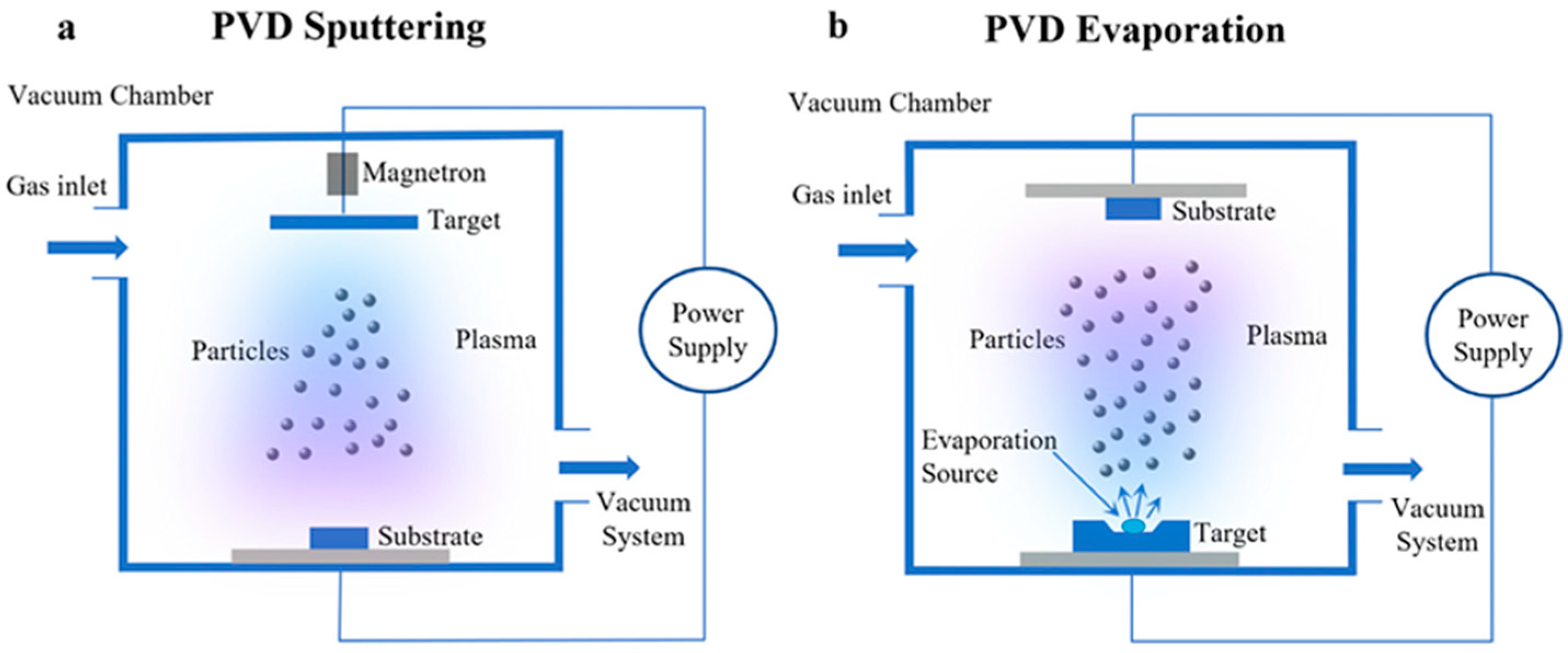

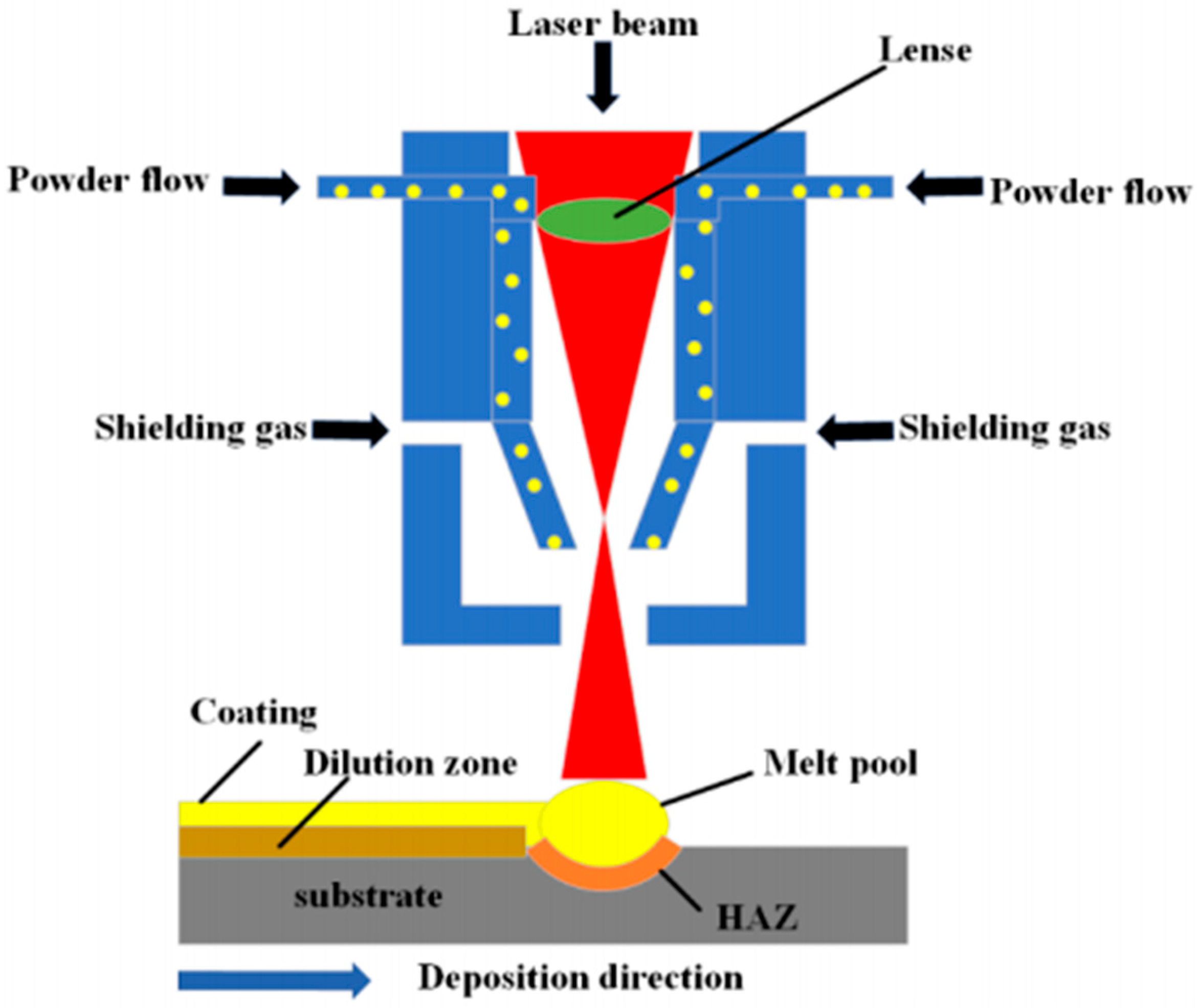

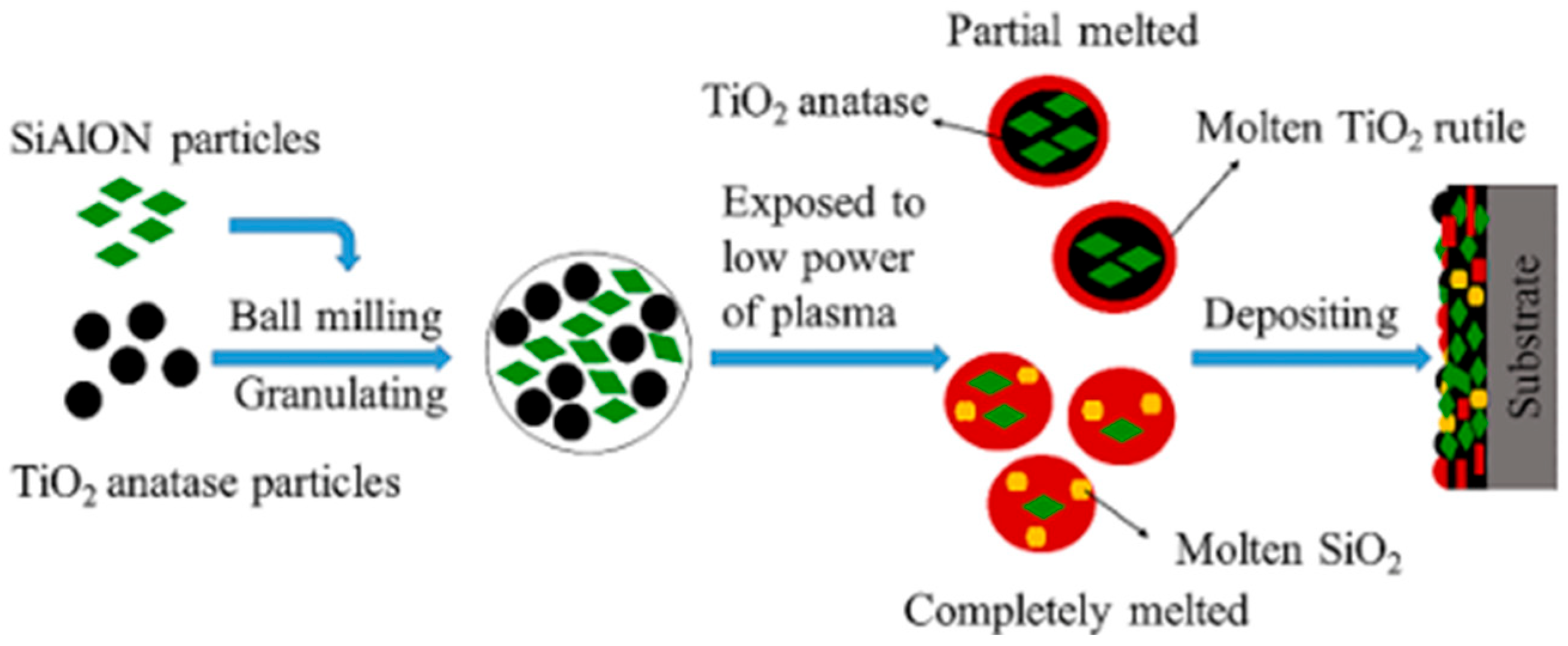

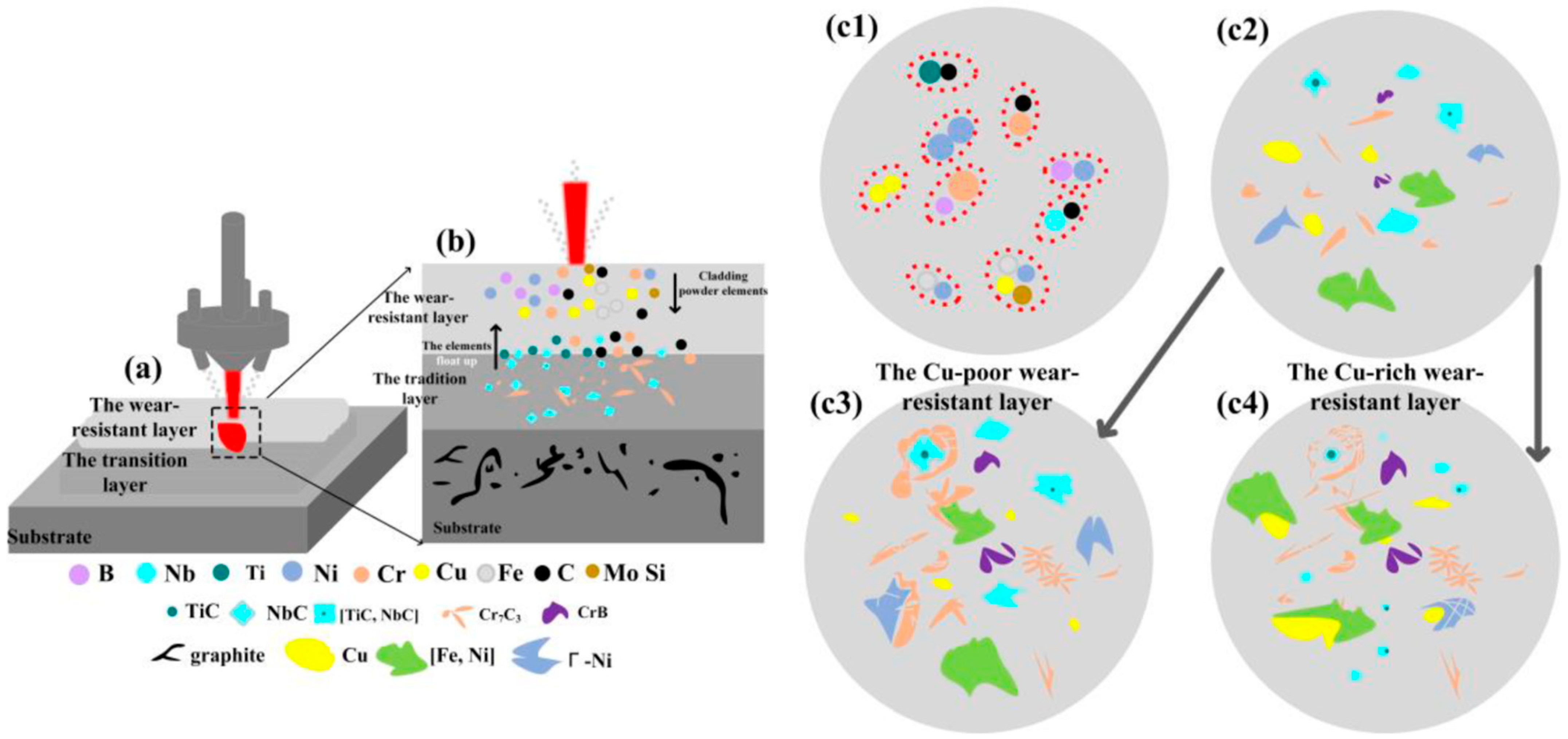

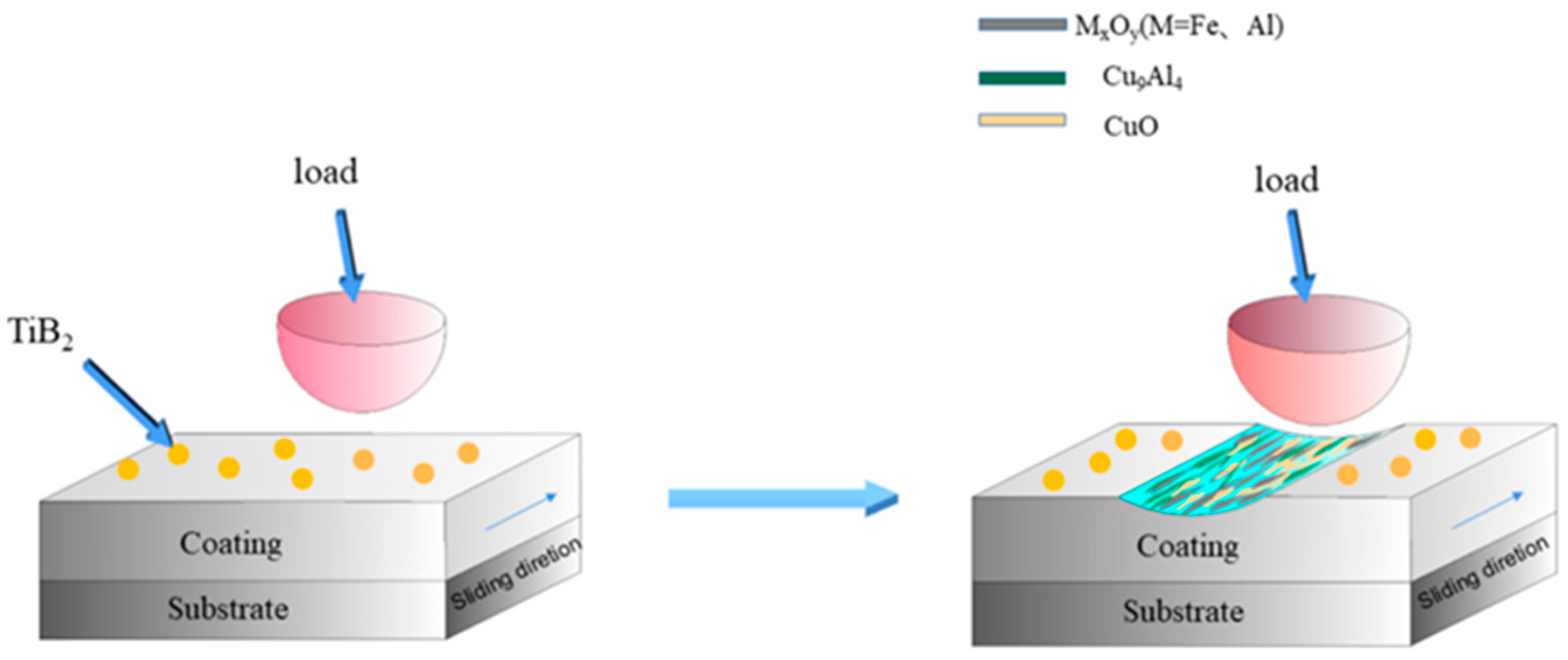
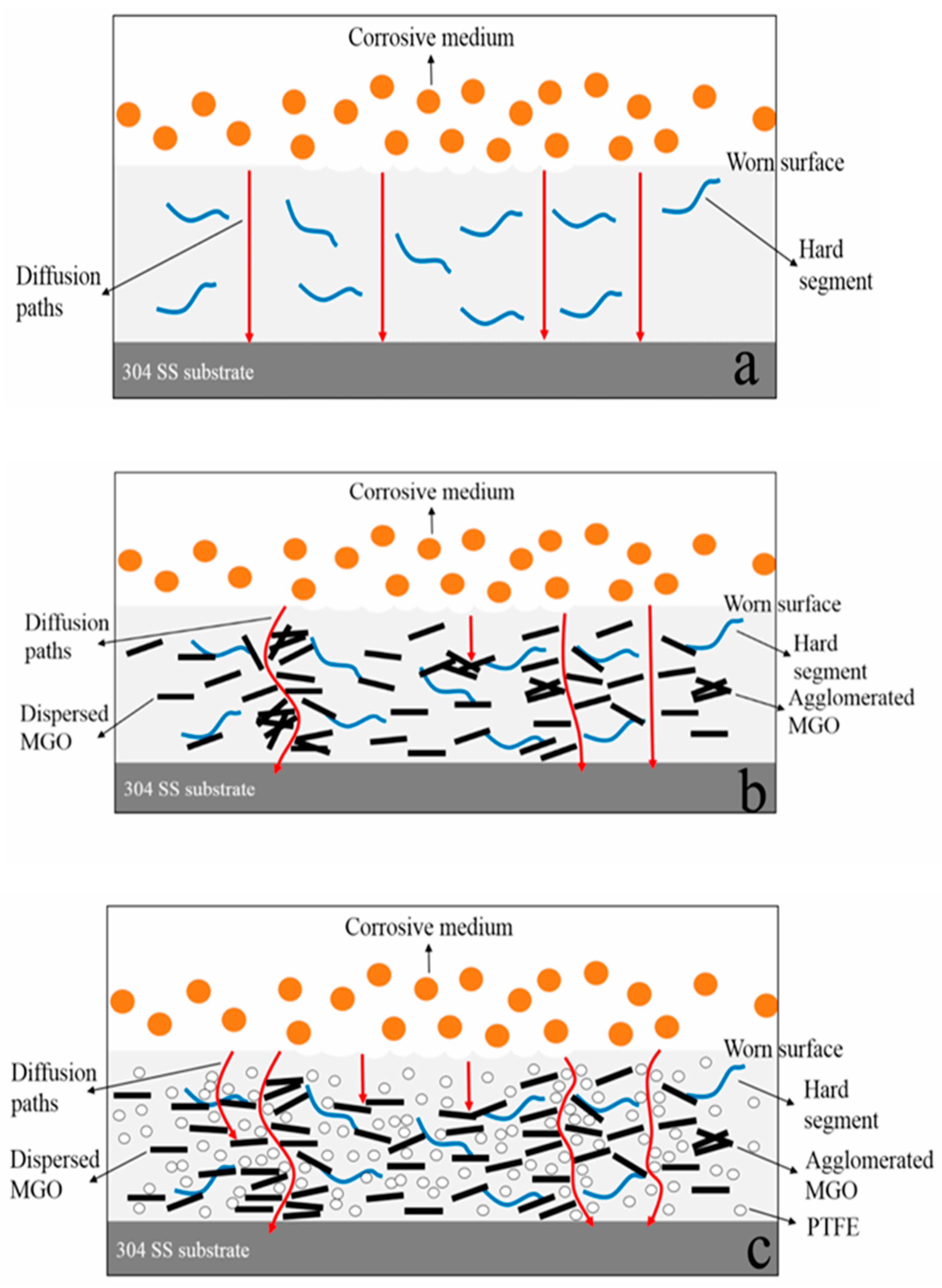
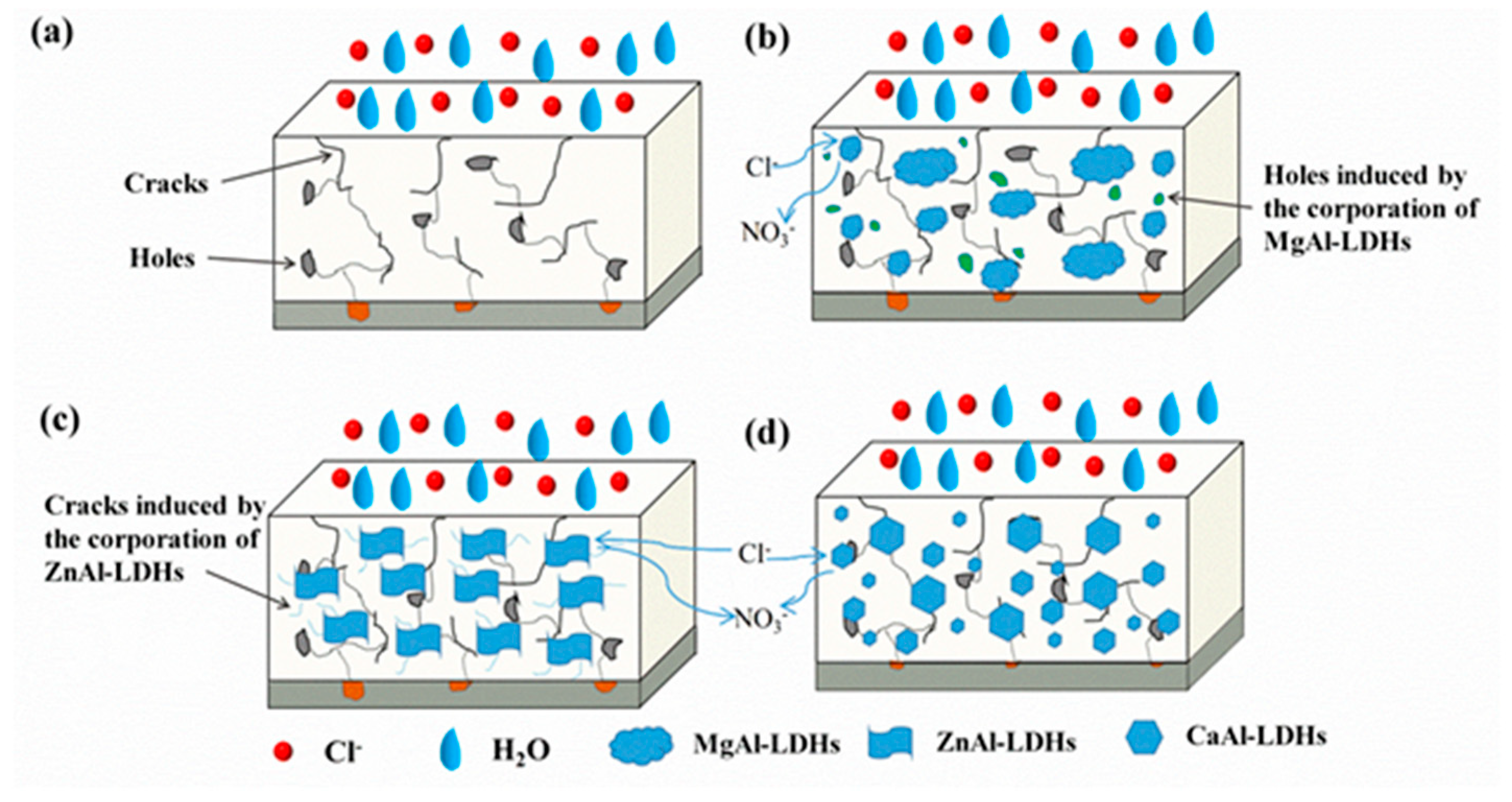

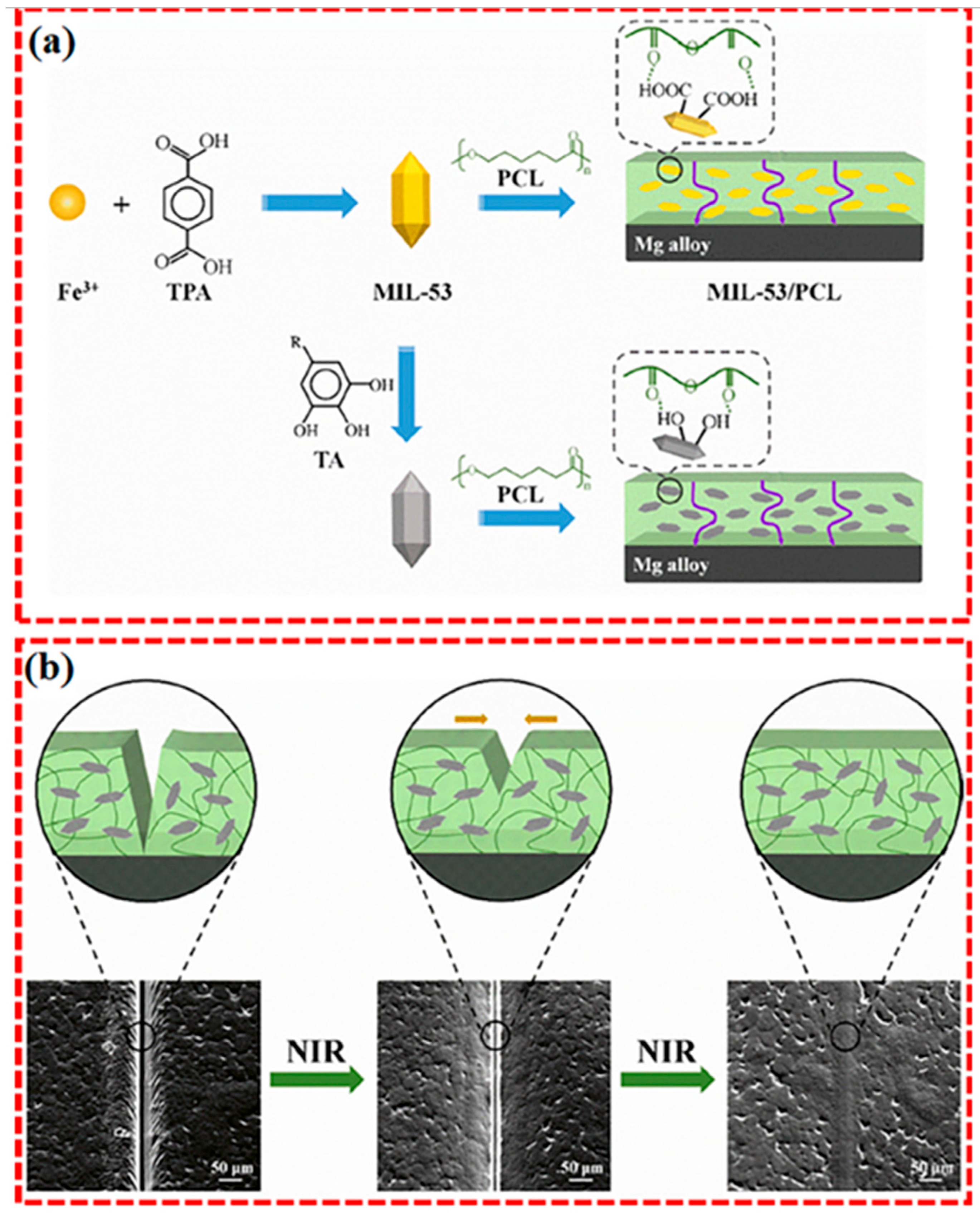

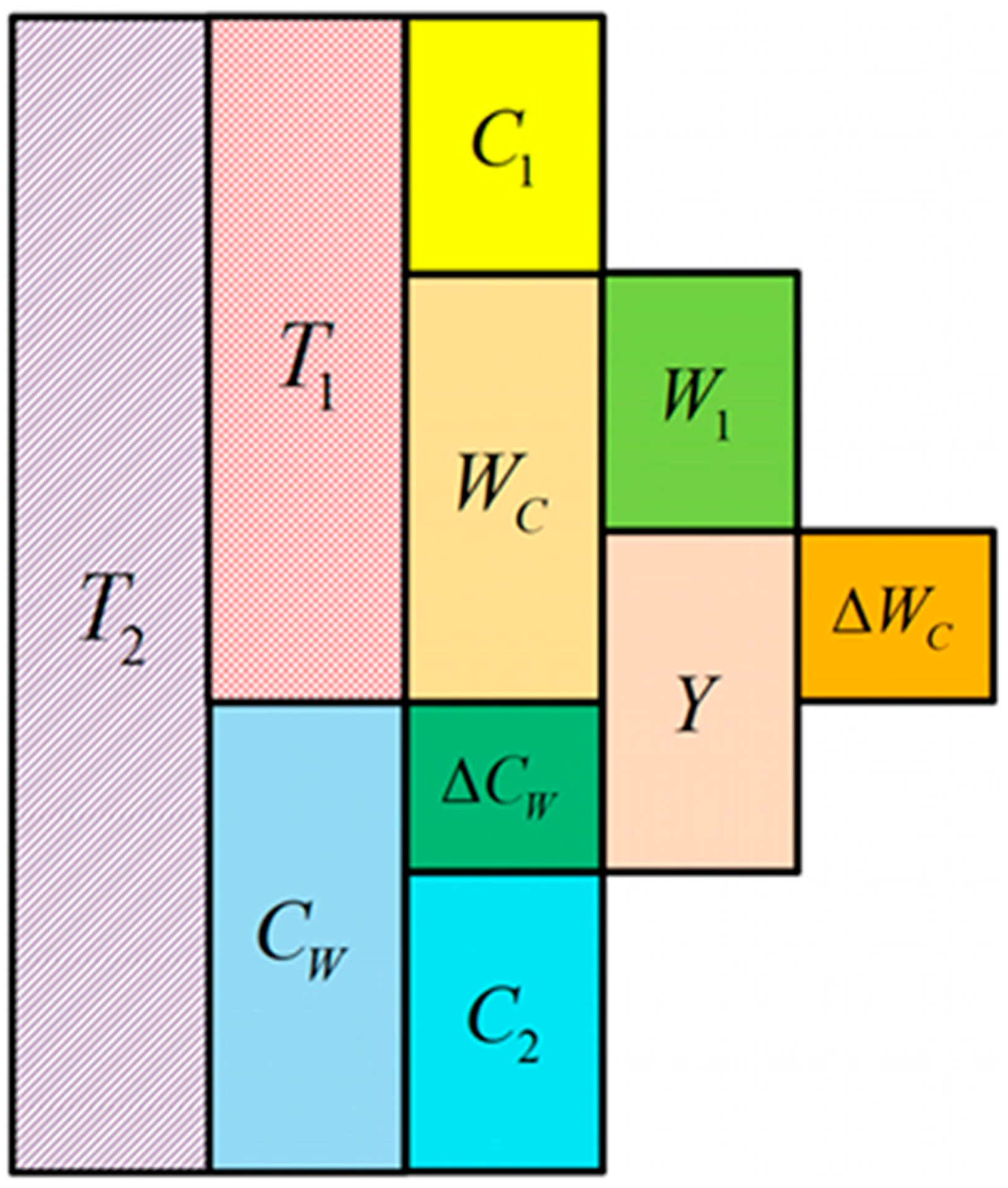
| Parameter | Wear-Resistant Coatings | Friction-Reducing Coatings | Self-Lubricating Coatings |
|---|---|---|---|
| Primary Mechanism | High hardness & toughness | Low shear strength at interface | In situ lubricant release |
| Energy Input | Thermal (Laser, Plasma jet) | Plasma (PVD); Electric (plating) | Thermal (Spray, Cladding) |
| Key Property | Hardness (1000–2000 HV) | Low COF (0.1–0.2) | Stable COF (0.01–0.3) |
| Advantage | High abrasion resistance | Energy saving | Maintenance-free operation |
| Limitation | Brittleness; High residual stress | Limited load-bearing capacity | Limited service life |
| Reference | [64,68,70] | [80,82,83] | [88,89,91] |
Disclaimer/Publisher’s Note: The statements, opinions and data contained in all publications are solely those of the individual author(s) and contributor(s) and not of MDPI and/or the editor(s). MDPI and/or the editor(s) disclaim responsibility for any injury to people or property resulting from any ideas, methods, instructions or products referred to in the content. |
© 2025 by the authors. Licensee MDPI, Basel, Switzerland. This article is an open access article distributed under the terms and conditions of the Creative Commons Attribution (CC BY) license (https://creativecommons.org/licenses/by/4.0/).
Share and Cite
Wang, X.; Zhao, W.; Shi, T.; Cheng, L.; Hu, S.; Zhou, C.; Cui, L.; Li, N.; Liaw, P.K. A Review on Tribological Wear and Corrosion Resistance of Surface Coatings on Steel Substrates. Coatings 2025, 15, 1314. https://doi.org/10.3390/coatings15111314
Wang X, Zhao W, Shi T, Cheng L, Hu S, Zhou C, Cui L, Li N, Liaw PK. A Review on Tribological Wear and Corrosion Resistance of Surface Coatings on Steel Substrates. Coatings. 2025; 15(11):1314. https://doi.org/10.3390/coatings15111314
Chicago/Turabian StyleWang, Xin, Wenqi Zhao, Tingting Shi, Lijuan Cheng, Suwen Hu, Chunxia Zhou, Li Cui, Ning Li, and Peter K. Liaw. 2025. "A Review on Tribological Wear and Corrosion Resistance of Surface Coatings on Steel Substrates" Coatings 15, no. 11: 1314. https://doi.org/10.3390/coatings15111314
APA StyleWang, X., Zhao, W., Shi, T., Cheng, L., Hu, S., Zhou, C., Cui, L., Li, N., & Liaw, P. K. (2025). A Review on Tribological Wear and Corrosion Resistance of Surface Coatings on Steel Substrates. Coatings, 15(11), 1314. https://doi.org/10.3390/coatings15111314







